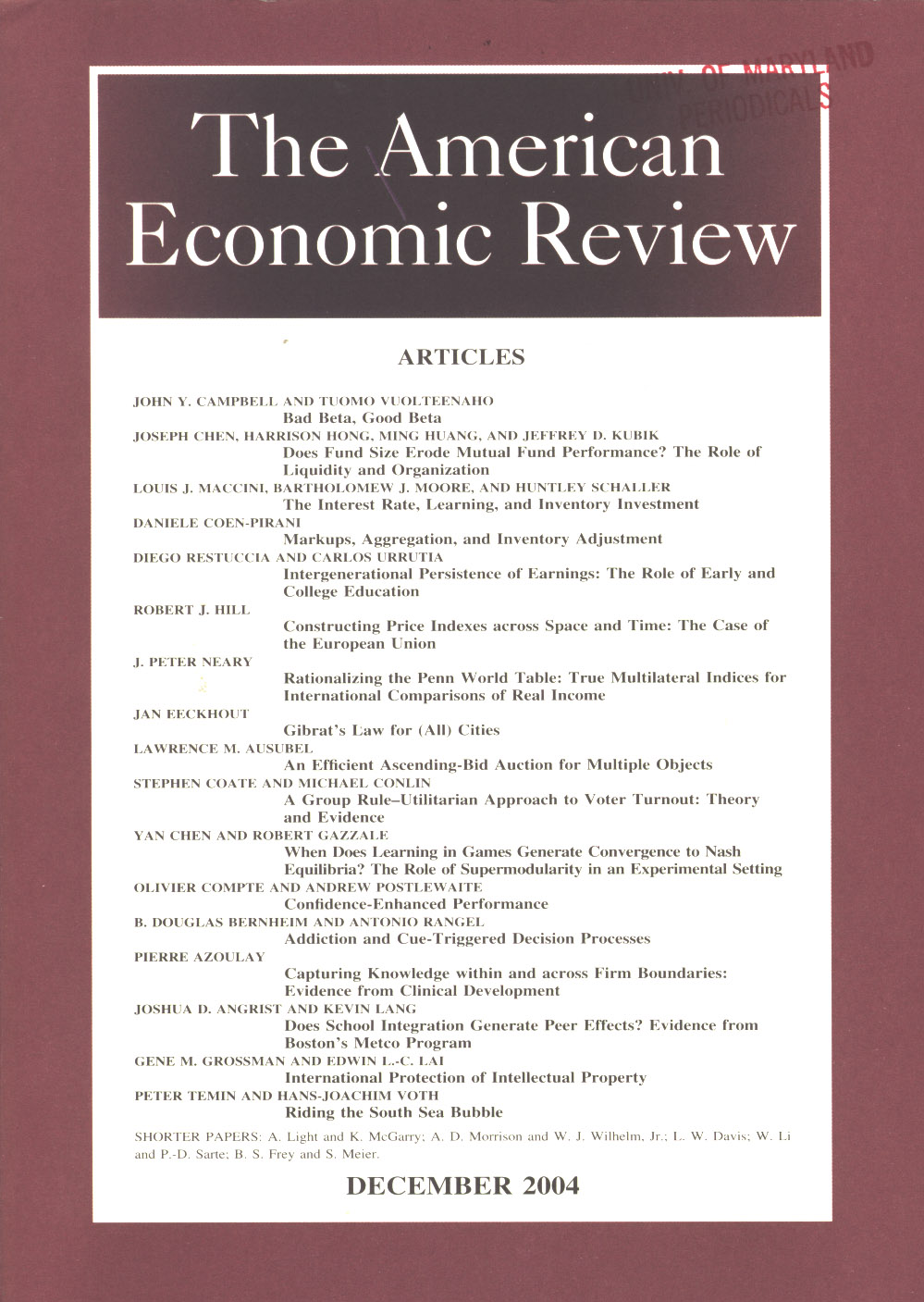Entrepreneurship, Innovation, and Productivity Growth
The research group “Entrepreneurship, Innovation, and Productivity Growth” tackles a broad set of research topics that are of relevance for our understanding of patterns of innovation and productivity growth and explores implications for workers and firms. Areas of particular focus include the decline in business dynamism, the growth in automation, entrepreneurship and innovation, and supply chains. The work is empirical in focus, it is grounded in microeconomic data research, but seeks to understand relevant macroeconomic trends.
Workpackage 1: Business Dynamism
The last decade has seen the explosion of research on business dynamism largely as a result of the development of new comprehensive firm and establishment level micro datasets. In this workpackage we exploit existing CompNet data to understand patterns of business dynamism in Europe.
In particular this subgroup seeks to explain the role of technological change and market power. The team documents the decline in young firm activity and reallocation, and estimates models that assess the causes and impacts on productivity growth (with Matthias Mertens, Sergio Inferrara, and Filippo Biondi).
Workpackage 2: Entrepreneurship
Going back to the days of Schumpeter, economists understand the important role entrepreneurs play in modern capitalist economies. This workpackage sets up a collaboration with the ZEW to develop a new data infrastructure and explore entrepreneurship in Germany broadly. Areas of research include:
a. Entrepreneurship and Firm Performance: Understanding High Growth Firms.
b. Innovative Firms and the Diffusion of Technology
c. (Im)Migration, Entrepreneurship and Regional Development
Workpackage 3: Automation
The introduction of robots and automation technologies in the workplace are fundamentally altering the balance of tasks and skills that are in demand. At the same time automation technologies increase the productivity of the workers and firms that make use of them relative to those that do not and can potentially lead to winners and losers. In this workpackage we conduct research on robot automation and its impacts on workers and firms. We focus our research both in Germany and the U.S..
The research group makes use of various administrative and survey datasets from a variety of sources and countries.
IWH Data Project: CompNet Database
The Competitiveness Research Network (CompNet) is a research network founded in 2012 to foster the debate on competitiveness issues among partner institutions and researchers. It aims at providing a robust theoretical and empirical link between micro-level drivers of competitiveness and macroeconomic performance for research and policy analysis purposes.
CompNet is funded by various European institutions, including among others: European Bank of Reconstruction and Development (EBRD); European Central Bank (ECB); European Commission (EC); European Investment Bank (EIB); European Stability Mechanism (ESM); France Stratégie; German Council of Economic Experts, Halle Institute for Economic Research (IWH); German Federal Ministry of Economic Affairs and Climate Action (BMWK); Tinbergen Institute (TI). CompNet is advised by leading researchers in the field of firm performance and has created a European micro-aggregated industry- and country-level database on indicators of firm- and country-level competitiveness and performance.
The database is unique in terms of its coverage and contents, particularly as, although being aggregated, it contains rich information on firm heterogeneity (i.e., distributional characteristics, like standard deviations and various percentiles of the firm distributions) across a large set of countries and industries in Europe. Among others, key variables included in the database are indicators of firm productivity, market power, firms’ financial situation, trade, and firm dynamics.
Research Cluster
Productivity and InstitutionsYour contact

- Department Centre for Business and Productivity Dynamics, Cbpd
Refereed Publications

Declining Dynamism, Allocative Efficiency, and the Productivity Slowdown
in: American Economic Review: Papers and Proceedings, No. 5, 2017
Abstract
A large literature documents declining measures of business dynamism including high-growth young firm activity and job reallocation. A distinct literature describes a slowdown in the pace of aggregate labor productivity growth. We relate these patterns by studying changes in productivity growth from the late 1990s to the mid 2000s using firm-level data. We find that diminished allocative efficiency gains can account for the productivity slowdown in a manner that interacts with the within-firm productivity growth distribution. The evidence suggests that the decline in dynamism is reason for concern and sheds light on debates about the causes of slowing productivity growth.

Taking the Leap: The Determinants of Entrepreneurs Hiring Their First Employee
in: Journal of Economics and Management Strategy, No. 1, 2017
Abstract
Job creation is one of the most important aspects of entrepreneurship, but we know relatively little about the hiring patterns and decisions of start‐ups. Longitudinal data from the Integrated Longitudinal Business Database (iLBD), Kauffman Firm Survey (KFS), and the Growing America through Entrepreneurship (GATE) experiment are used to provide some of the first evidence in the literature on the determinants of taking the leap from a nonemployer to employer firm among start‐ups. Several interesting patterns emerge regarding the dynamics of nonemployer start‐ups hiring their first employee. Hiring rates among the universe of nonemployer start‐ups are very low, but increase when the population of nonemployers is focused on more growth‐oriented businesses such as incorporated and employer identification number businesses. If nonemployer start‐ups hire, the bulk of hiring occurs in the first few years of existence. After this point in time, relatively few nonemployer start‐ups hire an employee. Focusing on more growth‐ and employment‐oriented start‐ups in the KFS, we find that Asian‐owned and Hispanic‐owned start‐ups have higher rates of hiring their first employee than white‐owned start‐ups. Female‐owned start‐ups are roughly 10 percentage points less likely to hire their first employee by the first, second, and seventh years after start‐up. The education level of the owner, however, is not found to be associated with the probability of hiring an employee. Among business characteristics, we find evidence that business assets and intellectual property are associated with hiring the first employee. Using data from the largest random experiment providing entrepreneurship training in the United States ever conducted, we do not find evidence that entrepreneurship training increases the likelihood that nonemployers hire their first employee.

Where Has All the Skewness Gone? The Decline in High-growth (Young) Firms in the U.S.
in: European Economic Review, July 2016
Abstract
The pace of business dynamism and entrepreneurship in the U.S. has declined over recent decades. We show that the character of that decline changed around 2000. Since 2000 the decline in dynamism and entrepreneurship has been accompanied by a decline in high-growth young firms. Prior research has shown that the sustained contribution of business startups to job creation stems from a relatively small fraction of high-growth young firms. The presence of these high-growth young firms contributes to a highly (positively) skewed firm growth rate distribution. In 1999, a firm at the 90th percentile of the employment growth rate distribution grew about 31 percent faster than the median firm. Moreover, the 90−50 differential was 16 percent larger than the 50−10 differential reflecting the positive skewness of the employment growth rate distribution. We show that the shape of the firm employment growth distribution changes substantially in the post-2000 period. By 2007, the 90−50 differential was only 4 percent larger than the 50−10, and it continued to exhibit a trend decline through 2011. The overall decline reflects a sharp drop in the 90th percentile of the growth rate distribution accounted for by the declining share of young firms and the declining propensity for young firms to be high-growth firms.

Declining Business Dynamism: What We Know and the Way Forward
in: American Economic Review: Papers and Proceedings, No. 5, 2016
Abstract
A growing body of evidence indicates that the U.S. economy has become less dynamic in recent years. This trend is evident in declining rates of gross job and worker flows as well as declining rates of entrepreneurship and young firm activity, and the trend is pervasive across industries, regions, and firm size classes. We describe the evidence on these changes in the U.S. economy by reviewing existing research. We then describe new empirical facts about the relationship between establishment-level productivity and employment growth, framing our results in terms of canonical models of firm dynamics and suggesting empirically testable potential explanations.

Private Equity, Jobs, and Productivity
in: American Economic Review, No. 12, 2014
Abstract
Private equity critics claim that leveraged buyouts bring huge job losses and few gains in operating performance. To evaluate these claims, we construct and analyze a new dataset that covers US buyouts from 1980 to 2005. We track 3,200 target firms and their 150,000 establishments before and after acquisition, comparing to controls defined by industry, size, age, and prior growth. Buyouts lead to modest net job losses but large increases in gross job creation and destruction. Buyouts also bring TFP gains at target firms, mainly through accelerated exit of less productive establishments and greater entry of highly productive ones.
Working Papers

Measuring the Impact of Household Innovation using Administrative Data
in: NBER Working Paper, No. 25259, 2018
Abstract
We link USPTO patent data to U.S. Census Bureau administrative records on individuals and firms. The combined dataset provides us with a directory of patenting household inventors as well as a time-series directory of self-employed businesses tied to household innovations. We describe the characteristics of household inventors by race, age, gender and U.S. origin, as well as the types of patented innovations pursued by these inventors. Business data allows us to highlight how patents shape the early life-cycle dynamics of nonemployer businesses. We find household innovators are disproportionately U.S. born, white and their age distribution has thicker tails relative to business innovators. Data shows there is a deficit of female and black inventors. Household inventors tend to work in consumer product areas compared to traditional business patents. While patented household innovations do not have the same impact of business innovations their uniqueness and impact remains surprisingly high. Back of the envelope calculations suggest patented household innovations granted between 2000 and 2011 might generate $5.0B in revenue (2000 dollars).













